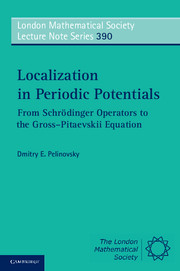Book contents
- Frontmatter
- Contents
- Preface
- 1 Formalism of the nonlinear Schrödinger equations
- 2 Justification of the nonlinear Schrödinger equations
- 3 Existence of localized modes in periodic potentials
- 4 Stability of localized modes
- 5 Traveling localized modes in lattices
- Appendix A Mathematical notation
- Appendix B Selected topics of applied analysis
- References
- Index
2 - Justification of the nonlinear Schrödinger equations
Published online by Cambridge University Press: 05 November 2011
- Frontmatter
- Contents
- Preface
- 1 Formalism of the nonlinear Schrödinger equations
- 2 Justification of the nonlinear Schrödinger equations
- 3 Existence of localized modes in periodic potentials
- 4 Stability of localized modes
- 5 Traveling localized modes in lattices
- Appendix A Mathematical notation
- Appendix B Selected topics of applied analysis
- References
- Index
Summary
As far as the laws of mathematics refer to reality, they are not certain, as far as they are certain, they do not refer to reality.
– Albert Einstein.The 20th century was the century of least squares, and the 21st may very well be that of ell-one magic.
– B.A. Cipra, “Ell 1-magic”, SIAM News (November 2006).Show us the equations! – a common wail of mathematicians when they hear physicists speak. Physicists argue that even the basic physical laws may incorrectly model nature. Physicists like to discuss various observations of real-world effects and thus admit a freedom of juggling with model equations and their simplifications.
This approach is however unacceptable in mathematics. Even if one model can be simplified to another model in a certain limit, mathematicians would like to understand the exact meaning of this simplification, proving convergence in some sense, studying bounds on the distance between solutions of the two models, and spending years in searches for sharper bounds.
Since this book is written for young mathematicians, we shall explain elements of analysis needed for rigorous justification of the nonlinear Dirac equations, the nonlinear Schrödinger equation, and the discrete nonlinear Schrödinger equation, in the context of the Gross–Pitaevskii equation with a periodic potential. Justification of nonlinear evolution equations in other contexts has been a subject of intense research in the past twenty years (see [186, 187] on the Korteweg–de Vries equations for water waves, [66, 68] on the Boussinesq equations for Fermi–Pasta–Ulam lattices, and [182, 183] on the Ginzburg–Landau equations for reaction–diffusion systems).
- Type
- Chapter
- Information
- Localization in Periodic PotentialsFrom Schrödinger Operators to the Gross–Pitaevskii Equation, pp. 51 - 117Publisher: Cambridge University PressPrint publication year: 2011

